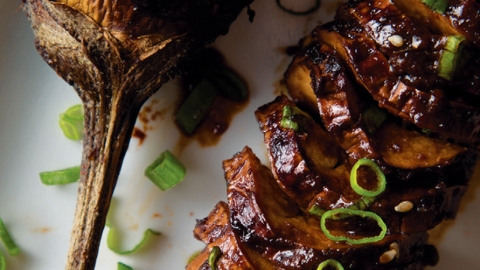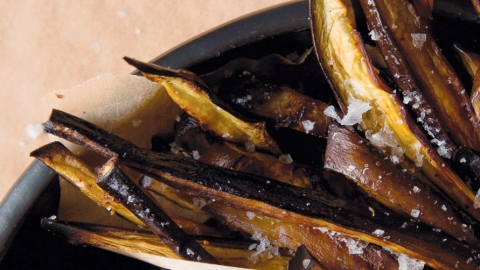Eggplant: A Purple Reign
“When I was alone, I lived on eggplant, the stove-top cook’s strongest ally…” —food writer Laurie Colwin
What is the season now? Late summer? Fall? Autumn? Shall we call it sumumn? Whatever the case, the plethora of vegetables—summer’s holdovers such as zucchini, peppers and eggplants—will line the tables at our local farmers’ markets until the first freeze makes this season’s plants obsolete. Until then, we choose to celebrate all that is aubergine (eggplants, that is): the royal-hued and often misunderstood local beauty.
Eggplant, or aubergine, as it is known in the UK, is a species of the nightshade family, as are tomatoes and potatoes. Dozens of eggplant varieties are grown worldwide, especially in Asia and its native India, where it is considered to be the king of vegetables. The plant gets its name both from the small, oval white varieties, which resemble an egg, and the larger fruits with a gorgeous purple hue, but skin color can also range from sunny yellow to green to bright pink or even black.
Beyond baba ganoush, the ubiquitous Mediterranean dip found on most mezze platters, eggplants can be broiled, grilled, stewed, roasted and hasselbacked. Often found in Indian and Asian curries, eggplants are friendly companions to many meat dishes but fare just as nicely as a star vegetable. And no matter where you hail from in the 50 states, eggplants are prolific, making them a winner for dinner. Let the purple reign begin.
Eggplant Tips
Overwhelmed by the varieties of eggplant staring at you from the farmers’ market tables? Don’t fret—for the most part, eggplant tastes like eggplant. Only the degree of bitterness varies somewhat. The main difference among the varieties is texture. Eggplant can be firm, even slightly stringy, or it can be creamy. You’ll just have to experiment a bit to find your favorites.
How to choose: Choose eggplants that are firm, even hard, to the touch, and have smooth, shiny skin with no shriveling or soft spots. Also check the calyx (the green leaves at the stem end): It should be fresh and green, not dried out and brown.
How to store: The best place to store eggplant is at room temperature, where it can sit comfortably for a day or two with no ill effects. After that, refrigerate them, but not for too long—they will go downhill fast after chilling in the refrigerator.







